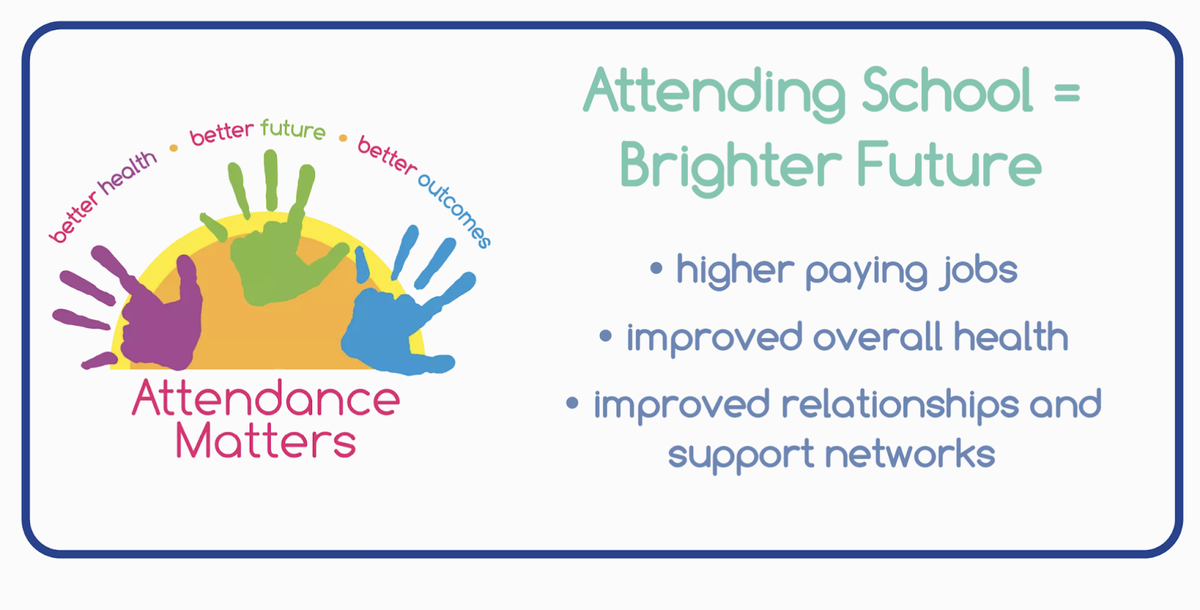Pastoral Wellbeing

Attendance
We’re thrilled to see such strong attendance across the school in Term 1! Our whole-school attendance started at an impressive 97.18% in Week 1, showing a fantastic commitment to learning.
A big congratulations to the 155 students who have maintained 100% attendance so far – your dedication is commendable! Additionally, it’s great to see a growing number of students in the 90-98% attendance range, demonstrating consistency in their learning.
A special shoutout to Prep AC, Year 2AP, and Year 3JS for showing strong and consistent attendance throughout the term.
Attending school every day helps build strong routines, develop friendships, and make the most of all the exciting learning experiences. Let’s keep up the fantastic effort as we move into the second half of the term!
Thank you to our families for your continued support in making every school day count.
✅ Why Attendance Matters
✅ Every school day counts! Regular attendance helps students stay connected, build friendships, and keep up with learning.
Thank you, families, for supporting your child’s routine and engagement at school.
Let’s keep building positive attendance habits together! 🎉 If you have any questions or need support, feel free to speak to your classroom teacher, Mrs. Antonowicz, Mrs. McSweeney or Mr. Podosky.
If you know that your child won’t be attending school, please contact the office and let them know that your child will be away!
PBIS
Each week we have a routine or a blitz that we are focusing on. This week’s is Attention Signals.
Supporting Positive Behaviour at St. Kilian’s
At St. Kilian’s, we are committed to creating a safe and respectful learning environment for all students. To support this, we have clear expectations around attention signals, hands-on behaviour, and problem-solving.
Routine: Tight Transitions
At school, we teach students how to transition between activities quickly, calmly, and efficiently to maximise learning time. A clear routine helps students manage their time, stay focused, and build independence.
How It Works at School:
- Teachers use a clear signal to get students’ attention.
- Students learn a step-by-step process for moving between activities.
- They practice transitioning smoothly, with positive reinforcement for following expectations.
How Parents Can Support at Home: You can help reinforce these skills at home by encouraging structured transitions in daily routines. Here are some simple strategies:
✅ Use Clear Signals: Give a warning before transitioning. Example: “In five minutes, we’ll pack away and start dinner.”
✅ Break Tasks into Steps: Help your child understand what to do next by using clear instructions. Example: “First, put your toys away, then wash your hands, and finally sit at the table.”
✅ Practice Quick & Calm Transitions: Encourage your child to move from one activity to another without distractions or delay.
✅ Praise & Reinforce Effort: Celebrate smooth transitions with encouragement. Example: “Great job getting ready for bed so quickly tonight!”
✅ Model Good Time Management: Show your child how you transition between tasks, like finishing a meal before starting clean-up.
By practicing these strategies at home, students develop important self-management skills that support their success at school and beyond. Thank you for working with us to help your child build positive learning habits! 😊
Hands-On Policy
We remind all students to keep their hands and feet to themselves. If a hands-on incident happens (such as pushing, hitting, or grabbing), staff will:
- Ensure everyone is safe and separate students if needed.
- Report the incident and follow up with leadership.
- Communicate with families so they are aware of what happened.
- Apply appropriate consequences, such as a break off the yard or loss of priviledges.
- Students who go hands-on will be off-break for 1 break.
- Support students with a restorative conversation to help them learn from the situation.
Our goal is to ensure a safe school environment where students feel supported and can learn positive ways to handle challenges.
💡 How Families Can Support at Home:
- Encourage positive ways to solve problems – Talk about using words instead of hands when feeling upset.
- Reinforce clear boundaries – Remind children that physical aggression is never okay and discuss alternative ways to express frustration.
- Talk through real-life scenarios – Ask, “What would you do if someone took your turn in a game?” to help students think through better responses.
Problem-Solving – Getting Help from an Adult
When problems arise, we encourage students to use their words and seek help from a teacher or staff member if they cannot solve the issue on their own. This might be if someone isn’t following the rules, if they feel unsafe, or if they need help working through a disagreement. Teachers are always available to listen, guide students through a solution, and ensure fairness.
💡 How Families Can Support at Home:
- Model problem-solving language – Phrases like “Can we find a way to share?” or “Let’s take turns” help students learn effective communication.
- Encourage independence – Before stepping in, ask “How do you think you could solve this?” to help them develop their own strategies.
- Remind students that teachers are here to help – Let them know it’s always okay to ask a teacher for help when needed.
By working together, we can continue to make St. Kilian’s a safe, respectful, and supportive place for everyone. Thank you for your partnership in reinforcing these expectations at home!

